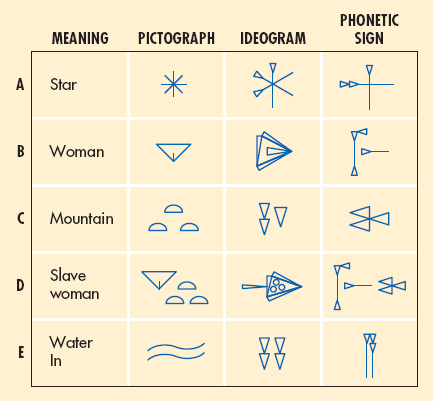Understanding World Societies:
Printed Page 40
Writing, Mathematics, and Poetry

(Source: Excerpted from S. N. Kramer, The Sumerians: Their History, Culture, and Character. Copyright © 1963 by the University of Chicago Press. Used by permission of The University of Chicago Press.)
The origins of writing probably date back to the ninth millennium B.C.E., when people in southwest Asia used clay tokens as counters for record keeping. By the fourth millennium people had realized that impressing the tokens on soft clay, or drawing pictures of the tokens on clay, was simpler than making tokens. This breakthrough in turn suggested that more information could be conveyed by adding pictures of other objects, and slowly the new technology of writing developed. The result was a complex system of pictographs in which each sign pictured an object, such as “star” (line A of Figure 2.1). These pictographs were the forerunners of the Sumerian form of writing known as cuneiform (kyou-
Pictographs were initially limited in that they could not represent abstract ideas, but the development of ideograms — signs that represented ideas — made writing more versatile. Thus the sign for “star” could also be used to indicate “heaven,” “sky,” or even “god.” The real breakthrough came when scribes started using signs to represent sounds.
The development of the Sumerian system of writing was piecemeal, with scribes making changes and additions as they were needed. The system became so complicated that the Sumerians established scribal schools, which by 2500 B.C.E. flourished throughout the region. Students at the schools were all male, and most came from families in the middle range of urban society. Scribal schools were primarily intended to produce individuals who could keep records of the property of temple officials, kings, and nobles. Thus writing first developed as a way to enhance the growing power of elites, not to record speech.
Sumerians wrote numbers as well as words on clay tablets, and some surviving tablets show multiplication and division problems. The Sumerians and later Mesopotamians made significant advances in mathematics using a numerical system based on units of sixty, ten, and six, from which we derive our division of hours into sixty minutes and minutes into sixty seconds. They also developed the concept of place value — that the value of a number depends on where it stands in relation to other numbers.
Written texts were not an important part of Sumerian religious life, nor were they central to the religious practices of most of the other peoples in this region. Stories about the gods circulated orally and traveled with people when they moved up and down the rivers. Sumerians also told stories about heroes and kings, many of which were eventually reworked into the world’s first epic poem, the Epic of Gilgamesh (GIL-